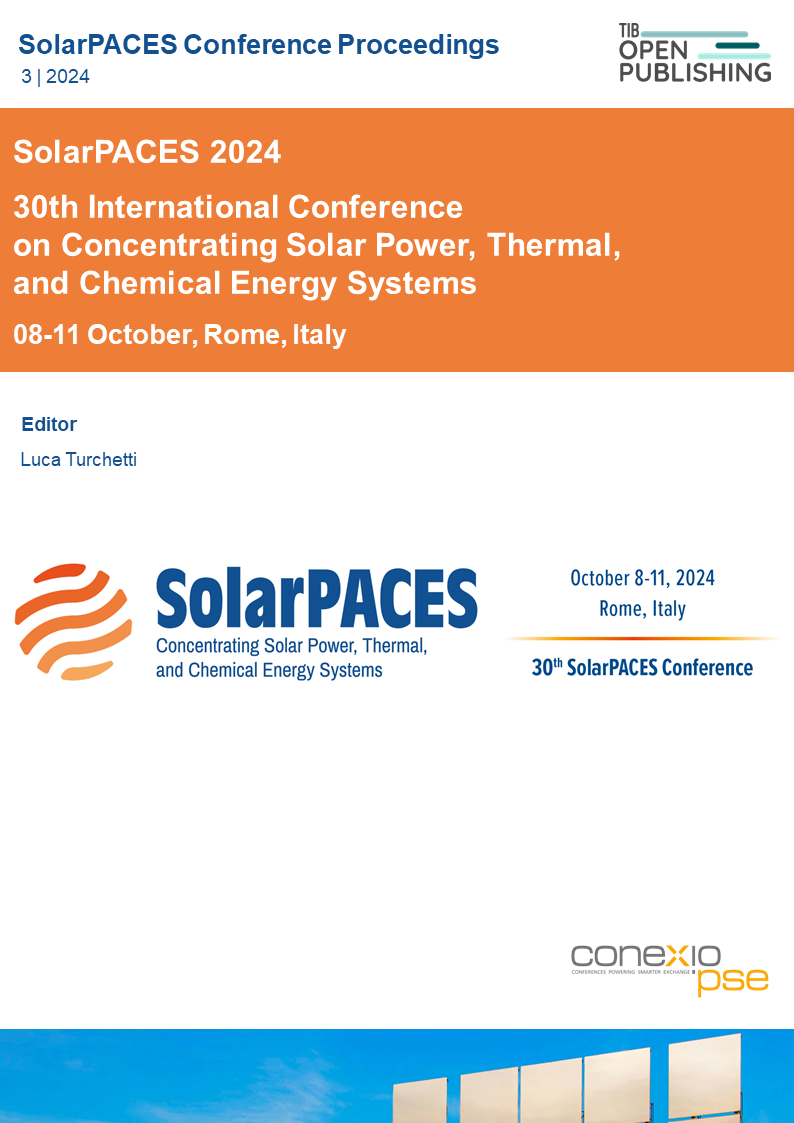Technoeconomic Analysis of a Solar Thermochemical Fuel Production Process Using a Packed-Bed Redox Reactor
DOI:
https://doi.org/10.52825/solarpaces.v3i.2429Keywords:
Solar Fuels, Solar Thermochemical Fuel Production, System ModelingAbstract
The production of synthetic liquid fuels at a competitive price is paramount to deploy them at scale in sectors such as the aviation and maritime industries. Solar thermochemical fuel production is a promising pathway to produce such fuels using concentrated solar thermal (CST) driving high-temperature redox reactions, coupled with a gas-to-liquid process. In this work we present a preliminary technoeconomic analysis of a solar fuels plant, utilizing a new fixed-bed countercurrent redox reactor and combining both CST and photovoltaic arrays to supply the required energy. Three case studies are examined: CST-PV hybrid, CST-PV hybrid with energy conversion between heat and electricity, and CST. All cases include a power block that utilizes the exothermic heat of oxidation. A TEA framework, based on reduced order modelling of the redox reactor, is used to correlate design and operating conditions to syngas production rate. Preliminary analysis shows that commercial viability is unattainable for reduction temperatures up to 1500°C, attributable to the low feedstock conversion. When increasing the reduction temperature to 1600°C, levelized costs of hydrocarbon feedstock below $10/gal are attainable. CST-PV hybrid with energy conversion is identified as the most promising configuration between the three configurations examined in this work. While calculated fuel costs are still much higher than those of fossil-based hydrocarbon fuels, several directions are identified that can improve their commercial viability, namely inclusion of thermal energy storage, increasing the overall plant scale, and further optimization of the CST and PV subsystems.
Downloads
References
S. Zoller et al., “A solar tower fuel plant for the thermochemical production of kerosene from H2O and CO2,” Joule, vol. 6, no. 7, pp. 1606–1616, Jul. 2022, doi: 10.1016/j.joule.2022.06.012.
A. Lidor and B. Bulfin, “A critical perspective and analysis of two-step thermochemical fuel production cycles,” Solar Compass, p. 100077, Jun. 2024, doi: 10.1016/j.solcom.2024.100077.
B. J. Hathaway, R. Bala Chandran, A. C. Gladen, T. R. Chase, and J. H. Davidson, “Demonstration of a Solar Reactor for Carbon Dioxide Splitting via the Isothermal Ceria Redox Cycle and Practical Implications,” Energy & Fuels, vol. 30, no. 8, pp. 6654–6661, Aug. 2016, doi: 10.1021/acs.energyfuels.6b01265.
A. Lidor, Y. Aschwanden, J. Häseli, P. Reckinger, P. Haueter, and A. Steinfeld, “High-temperature heat recovery from a solar reactor for the thermochemical redox splitting of H2O and CO2,” Applied Energy, vol. 329, p. 120211, Jan. 2023, doi: 10.1016/j.apenergy.2022.120211.
A. Lidor and L. Zimmermann, “Experimental demonstration of high-temperature heat re-covery in a solar reactor,” Solar Energy, vol. 262, p. 111915, Sep. 2023, doi: 10.1016/j.solener.2023.111915.
G. Zang, P. Sun, A. A. Elgowainy, A. Bafana, and M. Wang, “Performance and cost analysis of liquid fuel production from H2 and CO2 based on the Fischer-Tropsch pro-cess,” Journal of CO2 Utilization, vol. 46, p. 101459, Apr. 2021, doi: 10.1016/j.jcou.2021.101459.
I. S. Metcalfe et al., “Overcoming chemical equilibrium limitations using a thermodynami-cally reversible chemical reactor,” Nature Chemistry, vol. 11, no. 7, pp. 638–643, 2019, doi: 10.1038/s41557-019-0273-2.
B. Bulfin, M. Zuber, O. Gräub, and A. Steinfeld, “Intensification of the reverse water–gas shift process using a countercurrent chemical looping regenerative reactor,” Chemical Engineering Journal, vol. 461, Apr. 2023, doi: 10.1016/j.cej.2023.141896.
B. Bulfin et al., “Statistical thermodynamics of non-stoichiometric ceria and ceria zirconia solid solutions,” Physical Chemistry Chemical Physics, vol. 18, no. 33, pp. 23147–23154, 2016, doi: 10.1039/C6CP03158G.
G. Ambrosetti and P. Good, “A novel approach to high temperature solar receivers with an absorbing gas as heat transfer fluid and reduced radiative losses,” Solar Energy, vol. 183, no. February, pp. 521–531, 2019, doi: 10.1016/j.solener.2019.03.004.
A. de Klerk, Fischer‐Tropsch Refining. Wiley, 2011. doi: 10.1002/9783527635603.
K. Z. House, A. C. Baclig, M. Ranjan, E. A. van Nierop, J. Wilcox, and H. J. Herzog, “Economic and energetic analysis of capturing CO2 from ambient air,” Proceedings of the National Academy of Sciences, vol. 108, no. 51, pp. 20428–20433, Dec. 2011, doi: 10.1073/pnas.1012253108.
B. T. Gorman, M. Lanzarini-Lopes, N. G. Johnson, J. E. Miller, and E. B. Stechel, “Tech-no-Economic Analysis of a Concentrating Solar Power Plant Using Redox-Active Metal Oxides as Heat Transfer Fluid and Storage Media,” Front. Energy Res., vol. 9, Dec. 2021, doi: 10.3389/fenrg.2021.734288.
H. W. Häring, Industrial Gases Processing. Wiley-VCH, 2008. doi: 10.1002/9783527621248.
J. Theis, “Quality Guidelines for Energy Systems Studies: Cost Estimation Methodology for NETL Assessments of Power Plant Performance,” National Energy Technology La-boratory (NETL), Pittsburgh, PA, Morgantown, WV, and Albany, OR (United States), NETL-PUB-22580, Feb. 2021. doi: 10.2172/1567736.
E. Lewis et al., “Comparison of Commercial, State-of-the-Art, Fossil-Based Hydrogen Production Technologies,” National Energy Technology Laboratory (NETL), Pittsburgh, PA, Morgantown, WV, and Albany, OR (United States), DOE/NETL-2022/3241, Apr. 2022. doi: 10.2172/1862910.
J. A. Martin, E. C. D. Tan, D. A. Ruddy, J. King, and A. T. To, “Temperature–Pressure Swing Process for Reactive Carbon Capture and Conversion to Methanol: Techno-Economic Analysis and Life Cycle Assessment,” Environ. Sci. Technol., vol. 58, no. 31, pp. 13737–13747, Aug. 2024, doi: 10.1021/acs.est.4c02589.
A. Lidor, “Hydrogen–steam separation using mechanical vapor recompression cycle,” International Journal of Hydrogen Energy, vol. 94, pp. 664–668, Dec. 2024, doi: 10.1016/j.ijhydene.2024.11.040.
Downloads
Published
How to Cite
Conference Proceedings Volume
Section
License
Copyright (c) 2025 Alon Lidor, Zachary Hart, Janna Martinek

This work is licensed under a Creative Commons Attribution 4.0 International License.
Accepted 2025-04-10
Published 2025-11-19
Funding data
-
U.S. Department of Energy
Grant numbers Science Undergraduate Laboratory Internship (SULI) program
